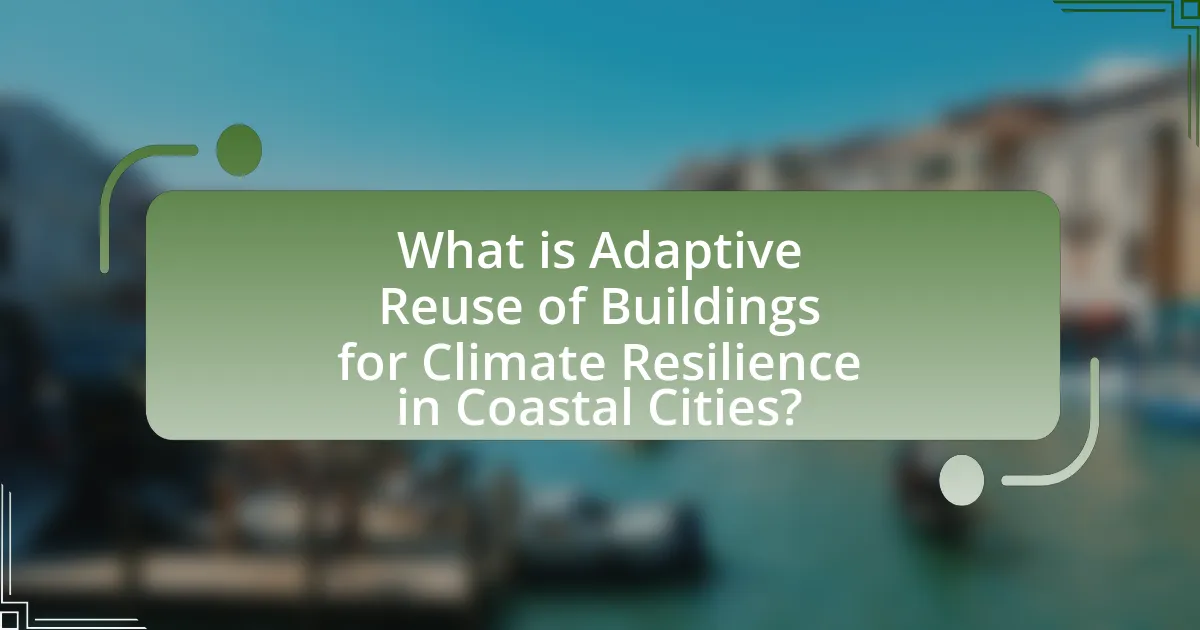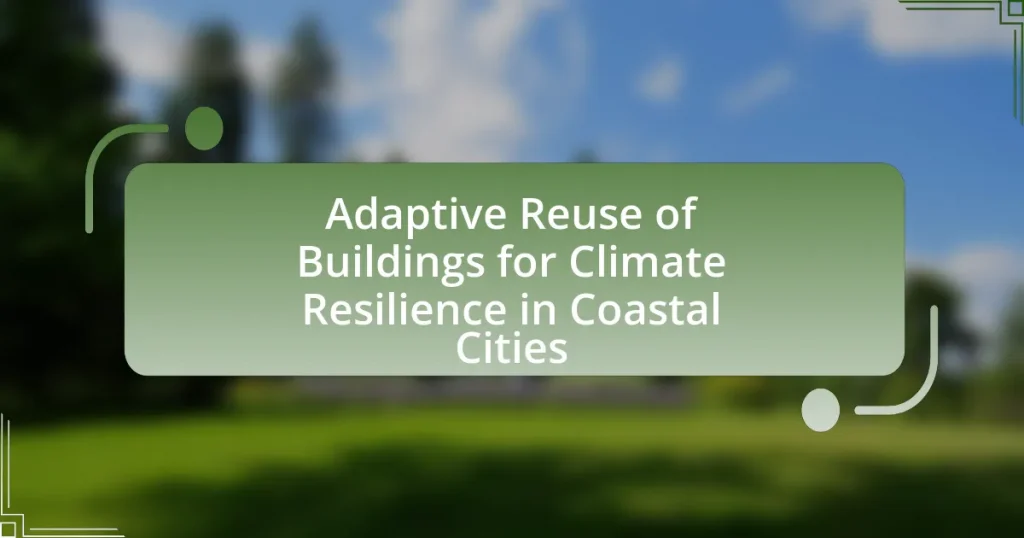The article focuses on the adaptive reuse of buildings as a strategy for enhancing climate resilience in coastal cities. It outlines how repurposing existing structures can mitigate the impacts of climate change, such as rising sea levels and increased storm intensity, while conserving resources and preserving cultural heritage. Key principles of adaptive reuse include sustainability, resilience, and community engagement, which collectively contribute to economic revitalization and social cohesion. The article also discusses the challenges coastal cities face regarding climate change, the benefits of adaptive reuse for local economies, and successful case studies that demonstrate effective implementation of these strategies.

What is Adaptive Reuse of Buildings for Climate Resilience in Coastal Cities?
Adaptive reuse of buildings for climate resilience in coastal cities involves repurposing existing structures to withstand the impacts of climate change, such as rising sea levels and increased storm intensity. This approach not only conserves resources and reduces waste but also enhances the adaptive capacity of urban environments. For instance, studies have shown that retrofitting older buildings with modern materials and technologies can significantly improve their resilience, as evidenced by projects in cities like New Orleans and Miami, where adaptive reuse has been integrated into urban planning strategies to mitigate climate risks.
How does adaptive reuse contribute to climate resilience?
Adaptive reuse contributes to climate resilience by repurposing existing structures, which reduces the demand for new materials and minimizes waste. This practice conserves resources and energy, as it often requires less energy than new construction, thereby lowering carbon emissions. For instance, a study by the National Trust for Historic Preservation found that adaptive reuse can reduce carbon emissions by up to 50% compared to new builds. Additionally, repurposed buildings can be designed to withstand climate impacts, such as flooding or extreme weather, enhancing their resilience. This approach not only preserves cultural heritage but also supports sustainable urban development in coastal cities facing climate challenges.
What are the key principles of adaptive reuse in coastal environments?
The key principles of adaptive reuse in coastal environments include sustainability, resilience, and community engagement. Sustainability focuses on minimizing environmental impact by repurposing existing structures rather than constructing new ones, which conserves resources and reduces waste. Resilience involves designing adaptations that withstand climate-related challenges, such as flooding and erosion, ensuring that reused buildings can endure changing coastal conditions. Community engagement emphasizes involving local stakeholders in the decision-making process, fostering a sense of ownership and ensuring that the repurposed spaces meet the needs of the community. These principles are supported by case studies demonstrating successful adaptive reuse projects that enhance both environmental and social outcomes in coastal areas.
How does adaptive reuse differ from traditional building practices?
Adaptive reuse involves repurposing existing buildings for new uses, while traditional building practices typically focus on constructing new structures from the ground up. Adaptive reuse emphasizes sustainability by minimizing waste and preserving historical architecture, which can reduce the environmental impact associated with new construction. For instance, a study by the National Trust for Historic Preservation indicates that adaptive reuse can save up to 50% of the energy required for new buildings by utilizing existing materials and infrastructure. This approach not only conserves resources but also fosters community identity by maintaining cultural landmarks, contrasting with traditional practices that may overlook these aspects.
Why is adaptive reuse important for coastal cities?
Adaptive reuse is important for coastal cities because it enhances resilience against climate change while preserving cultural heritage. By repurposing existing structures, coastal cities can reduce waste and lower carbon emissions associated with new construction, as demonstrated by studies showing that adaptive reuse can decrease energy consumption by up to 50%. Furthermore, this approach helps maintain the historical character of coastal communities, which is vital for tourism and local identity, as evidenced by successful projects in cities like New Orleans and San Francisco that have revitalized neighborhoods while mitigating flood risks.
What challenges do coastal cities face regarding climate change?
Coastal cities face significant challenges regarding climate change, primarily due to rising sea levels, increased flooding, and extreme weather events. These cities are particularly vulnerable as they often have dense populations and critical infrastructure located near shorelines. For instance, a study by the National Oceanic and Atmospheric Administration (NOAA) indicates that sea levels along the U.S. coast could rise by up to 6.6 feet by 2100 if greenhouse gas emissions continue at the current rate. This rise threatens to inundate coastal areas, disrupt local economies, and displace communities. Additionally, coastal cities must contend with the increased frequency and intensity of hurricanes and storms, which can lead to severe property damage and economic losses. The combination of these factors necessitates urgent adaptive measures, including the adaptive reuse of buildings to enhance climate resilience.
How can adaptive reuse mitigate the impacts of rising sea levels?
Adaptive reuse can mitigate the impacts of rising sea levels by transforming existing structures into resilient spaces that can withstand flooding and other climate-related challenges. This approach reduces the need for new construction, which often disrupts natural landscapes and increases vulnerability to sea-level rise. For instance, retrofitting buildings with elevated foundations, flood-resistant materials, and improved drainage systems enhances their ability to cope with water intrusion. Studies indicate that adaptive reuse projects can significantly lower carbon emissions associated with new construction, as they utilize existing resources and infrastructure. Additionally, cities like New Orleans have successfully implemented adaptive reuse strategies to revitalize waterfront areas while addressing the risks posed by rising sea levels, demonstrating the effectiveness of this approach in enhancing urban resilience.
What are the benefits of adaptive reuse for communities?
Adaptive reuse provides multiple benefits for communities, including economic revitalization, preservation of cultural heritage, and environmental sustainability. By repurposing existing structures, communities can stimulate local economies through job creation and increased property values, as seen in cities like Detroit, where adaptive reuse projects have led to significant economic growth. Additionally, adaptive reuse helps maintain historical architecture, fostering a sense of identity and continuity within communities. Environmentally, it reduces waste and resource consumption, as repurposing buildings minimizes the need for new materials, contributing to climate resilience efforts in coastal cities.
How does adaptive reuse enhance local economies?
Adaptive reuse enhances local economies by revitalizing underutilized properties, which stimulates job creation and increases local tax revenues. For instance, a study by the National Trust for Historic Preservation found that adaptive reuse projects generate approximately 50% more jobs than new construction projects. Additionally, these projects often attract new businesses and tourism, further boosting economic activity in the area. By preserving historical structures, adaptive reuse also fosters community identity, which can lead to increased property values and investment in surrounding neighborhoods.
What social benefits arise from adaptive reuse projects?
Adaptive reuse projects provide significant social benefits, including community revitalization, preservation of cultural heritage, and increased social interaction. These projects often transform underutilized or abandoned structures into functional spaces, fostering a sense of community identity and pride. For instance, studies show that adaptive reuse can enhance local economies by attracting businesses and tourism, which in turn creates jobs and promotes social cohesion. Additionally, by preserving historical buildings, adaptive reuse projects maintain cultural narratives and contribute to the aesthetic value of neighborhoods, further encouraging community engagement and participation.
How can stakeholders implement adaptive reuse effectively?
Stakeholders can implement adaptive reuse effectively by engaging in comprehensive planning that incorporates community input, environmental assessments, and financial feasibility studies. This approach ensures that the repurposing of buildings aligns with local needs and sustainability goals. For instance, the National Trust for Historic Preservation emphasizes the importance of stakeholder collaboration in identifying potential sites and assessing their historical significance, which can enhance community identity while promoting climate resilience. Additionally, utilizing funding mechanisms such as tax incentives and grants can facilitate the financial viability of adaptive reuse projects, as evidenced by successful initiatives in cities like New Orleans, where adaptive reuse has contributed to both economic revitalization and environmental sustainability.
What are the common barriers to adaptive reuse in coastal cities?
Common barriers to adaptive reuse in coastal cities include regulatory constraints, financial challenges, and environmental risks. Regulatory constraints often arise from zoning laws and building codes that may not accommodate the modifications needed for adaptive reuse. Financial challenges can stem from high renovation costs and limited access to funding or incentives for such projects. Environmental risks, particularly related to climate change and rising sea levels, complicate the feasibility of reusing existing structures, as they may require significant retrofitting to ensure resilience against flooding and other climate impacts.

What specific strategies can be employed in adaptive reuse projects?
Specific strategies employed in adaptive reuse projects include structural reinforcement, sustainable design integration, and community engagement. Structural reinforcement ensures that existing buildings can withstand climate-related stresses, such as flooding and high winds, which is crucial for coastal cities. Sustainable design integration involves using eco-friendly materials and energy-efficient systems to reduce the environmental impact of the building, aligning with climate resilience goals. Community engagement fosters local support and input, ensuring that the repurposed buildings meet the needs of residents and enhance social cohesion. These strategies collectively contribute to the effectiveness and sustainability of adaptive reuse projects in addressing climate challenges.
How can design principles be applied to enhance resilience?
Design principles can enhance resilience by incorporating flexibility, sustainability, and community engagement into building designs. Flexibility allows structures to adapt to changing environmental conditions, such as rising sea levels or increased storm intensity, which is crucial for coastal cities. Sustainable materials and energy-efficient systems reduce environmental impact and operational costs, contributing to long-term resilience. Community engagement in the design process ensures that the needs and values of local populations are met, fostering a sense of ownership and responsibility towards the built environment. Research indicates that buildings designed with these principles can withstand climate-related stresses better, as evidenced by case studies in cities like New Orleans and Miami, where adaptive reuse projects have successfully mitigated risks associated with climate change.
What role does sustainable architecture play in adaptive reuse?
Sustainable architecture plays a crucial role in adaptive reuse by promoting the efficient use of resources and minimizing environmental impact during the renovation of existing structures. This approach not only preserves historical and cultural significance but also reduces waste and energy consumption associated with new construction. For instance, studies indicate that adaptive reuse can lead to a 50% reduction in carbon emissions compared to new builds, as it often utilizes existing materials and infrastructure. By integrating sustainable design principles, such as energy efficiency and water conservation, adaptive reuse projects enhance the resilience of buildings in coastal cities, making them better equipped to withstand climate-related challenges.
How can technology be integrated into adaptive reuse designs?
Technology can be integrated into adaptive reuse designs through the use of smart building systems, energy-efficient materials, and advanced construction techniques. Smart building systems, such as IoT sensors and automation, enhance energy management and occupant comfort by monitoring and adjusting lighting, heating, and cooling in real-time. Energy-efficient materials, like recycled insulation and sustainable finishes, reduce the environmental impact of renovations while improving building performance. Advanced construction techniques, including modular construction and 3D printing, streamline the renovation process, allowing for quicker adaptation of existing structures to meet modern needs. These integrations not only enhance the functionality and sustainability of reused buildings but also contribute to climate resilience in coastal cities by minimizing resource consumption and reducing carbon footprints.
What funding and policy frameworks support adaptive reuse?
Funding and policy frameworks that support adaptive reuse include federal and state tax incentives, grants, and zoning regulations that promote the conversion of existing structures for new uses. For instance, the Federal Historic Preservation Tax Incentives program provides a 20% tax credit for the rehabilitation of historic buildings, encouraging developers to invest in adaptive reuse projects. Additionally, many states offer their own tax credits and grants specifically aimed at revitalizing urban areas through adaptive reuse, such as California’s Adaptive Reuse Ordinance, which streamlines the permitting process for converting underutilized buildings. These frameworks not only provide financial support but also create a regulatory environment that facilitates the transformation of existing buildings, thereby enhancing climate resilience in coastal cities by reducing the need for new construction and preserving valuable resources.
What types of financial incentives are available for adaptive reuse projects?
Financial incentives for adaptive reuse projects include tax credits, grants, low-interest loans, and zoning allowances. Tax credits, such as the Federal Historic Preservation Tax Incentives program, provide a 20% credit for the rehabilitation of historic buildings, encouraging preservation while promoting sustainable development. Grants from local, state, or federal agencies can fund specific projects, while low-interest loans help finance the conversion of existing structures. Additionally, zoning allowances may facilitate adaptive reuse by relaxing regulations, thus making it easier to repurpose buildings for new uses. These incentives collectively support the economic viability and environmental sustainability of adaptive reuse initiatives.
How do zoning laws affect adaptive reuse initiatives?
Zoning laws significantly influence adaptive reuse initiatives by dictating the types of activities permitted in specific areas, which can either facilitate or hinder the transformation of existing structures. For instance, if zoning regulations do not allow for residential use in a commercial building, adaptive reuse efforts to convert that building into housing will be obstructed. Additionally, zoning laws may impose restrictions on building height, density, and design, which can limit the feasibility of certain adaptive reuse projects. According to the American Planning Association, flexible zoning codes that encourage mixed-use developments can enhance adaptive reuse by allowing a broader range of uses, thereby promoting sustainability and preserving historical structures.

What are the case studies of successful adaptive reuse in coastal cities?
Successful case studies of adaptive reuse in coastal cities include the transformation of the Pier 57 in New York City, which was converted from a dilapidated shipping terminal into a vibrant mixed-use space featuring retail, dining, and public areas. This project not only preserved historical architecture but also enhanced community engagement and resilience against climate impacts. Another example is the redevelopment of the former industrial site at the South Waterfront in Portland, Oregon, where old warehouses were repurposed into residential and commercial spaces, contributing to urban density and sustainability. These projects demonstrate how adaptive reuse can revitalize coastal urban areas while addressing environmental challenges.
What lessons can be learned from notable adaptive reuse projects?
Notable adaptive reuse projects demonstrate that integrating historical structures into modern urban environments can enhance sustainability and community identity. These projects often reveal the importance of preserving cultural heritage while addressing contemporary needs, as seen in the transformation of the High Line in New York City, which repurposed an old railway into a vibrant public park. Additionally, adaptive reuse can significantly reduce waste and resource consumption; for instance, the Tate Modern in London converted a former power station into a leading art museum, minimizing the environmental impact associated with new construction. Such examples underscore the potential for adaptive reuse to foster economic revitalization and social cohesion in coastal cities facing climate challenges.
How did specific projects address climate resilience challenges?
Specific projects addressed climate resilience challenges by implementing adaptive reuse strategies that repurpose existing buildings to withstand climate impacts. For instance, the transformation of historic warehouses into multifunctional community centers in coastal cities has enhanced local infrastructure while preserving cultural heritage. These projects often incorporate flood-resistant designs, such as elevated structures and permeable surfaces, which mitigate the risks of flooding and storm surges. Evidence of their effectiveness can be seen in cities like New Orleans, where adaptive reuse projects have reduced vulnerability to hurricanes and improved community resilience by providing essential services in safer, repurposed spaces.
What innovative solutions were implemented in these case studies?
Innovative solutions implemented in the case studies include the retrofitting of existing structures to enhance their resilience against climate impacts, such as flooding and sea-level rise. For instance, one case study showcased the elevation of buildings above projected flood levels, utilizing stilts or raised foundations to mitigate water damage. Additionally, the integration of green roofs and permeable surfaces was employed to manage stormwater runoff effectively, reducing urban heat and improving biodiversity. These approaches are supported by evidence from urban resilience frameworks that highlight the effectiveness of adaptive reuse in minimizing environmental impact while preserving cultural heritage.
What best practices should be followed in adaptive reuse projects?
Best practices in adaptive reuse projects include thorough site analysis, community engagement, and sustainable design principles. Conducting a comprehensive site analysis ensures that the existing structure’s strengths and weaknesses are identified, allowing for informed decision-making. Engaging the community fosters support and addresses local needs, which can enhance the project’s acceptance and success. Implementing sustainable design principles, such as energy efficiency and the use of environmentally friendly materials, contributes to climate resilience and reduces the overall environmental impact. These practices are supported by case studies showing that adaptive reuse can significantly lower carbon footprints compared to new construction, making it a viable strategy for enhancing resilience in coastal cities.
How can community engagement improve adaptive reuse outcomes?
Community engagement can significantly improve adaptive reuse outcomes by ensuring that the needs and preferences of local stakeholders are incorporated into the design and implementation processes. Engaging the community fosters a sense of ownership and pride, which can lead to increased support for projects and better alignment with local cultural and historical contexts. For instance, studies have shown that projects involving community input often experience higher rates of success and sustainability, as they reflect the values and aspirations of the community. Additionally, community engagement can facilitate collaboration among various stakeholders, including government entities, non-profits, and private developers, leading to more comprehensive and effective reuse strategies that address both environmental and social challenges.
What are the key considerations for maintaining historical integrity?
Key considerations for maintaining historical integrity include preserving original architectural features, ensuring accurate documentation of historical significance, and adhering to established preservation standards. Preserving original architectural features, such as facades, materials, and structural elements, is crucial to maintaining the building’s historical character. Accurate documentation involves researching and recording the building’s history, which helps inform restoration efforts and ensures that changes respect the original design intent. Adhering to established preservation standards, such as those set by the Secretary of the Interior’s Standards for the Treatment of Historic Properties, provides guidelines that help maintain the integrity of historical structures while allowing for necessary adaptations to meet modern needs.
What practical steps can communities take to promote adaptive reuse?
Communities can promote adaptive reuse by implementing zoning regulations that encourage the conversion of existing structures for new purposes. These regulations can include incentives such as tax breaks or grants for property owners who undertake adaptive reuse projects. Additionally, communities can establish design guidelines that facilitate the integration of modern amenities while preserving historical elements, thus maintaining cultural heritage. Public awareness campaigns can also be effective, educating residents about the benefits of adaptive reuse, such as reduced environmental impact and preservation of local character. Furthermore, partnerships with local businesses and non-profits can foster collaborative projects that enhance community engagement and investment in adaptive reuse initiatives.




